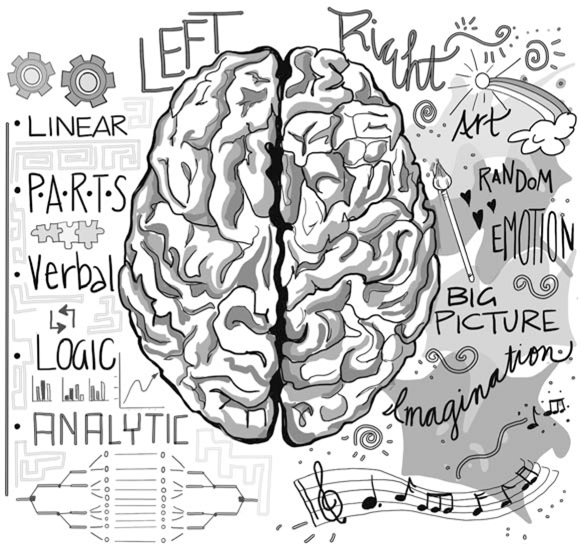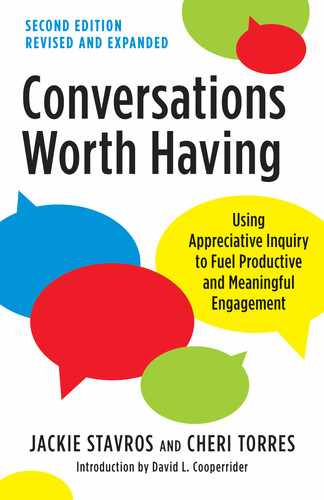7
It’s Not Magic, It’s Science!

No matter what people tell you, words and ideas can change the world.
—Nancy H. Kleinbaum
If the experience of our clients, families, and colleagues detailed in the stories in this book has not convinced you that there is magic in conversations worth having, then perhaps the evidence from more than thirty-five years of scientific research will help explain how generative questions and positive framing bring forth the best in human nature. This research falls into three distinct areas: neuroscience,1 positive image/position action, and positive psychology.2 The net outcome of this research points to the importance of using language to inspire positive emotions, positive images, and positive actions. Science tells us to follow the 80/20 rule—a ratio of 80 percent positive emotions and imagery to 20 percent negative—to support well-being and excellence at the individual, group, and organization levels.3 We’ll begin with neuroscience.
Neuroscience
In 1990, the invention of functional magnetic resonance imaging (fMRI) enabled neuroscientists to see and measure brain activity. The technology allowed scientists to see what happens to our neurophysiology under different conditions. Researchers could engage people in different kinds of conversations and activities and detect what was going on with their brain chemistry by measuring changes in blood flow. Neurological brain research has shown that strong beliefs and imagery actually change brain chemistry.4 It also has shown that brain chemistry influences our response to a given stimulus.
For example, Tony, an accountant for a small accounting firm, recently had an argument with his boss that left him believing he is going to be fired. He also knows that without his income, his family can’t make its mortgage. These beliefs create a neural “preset” that has him wired to react negatively when his wife suggests they go out to dinner. Had he instead had an experience with his boss that left him sure he was going to get a raise, he would have been delighted to go out to dinner with his wife. This is where tuning in can help us better respond to the world around us. We have the ability to influence our brain chemistry simply by pausing, taking several deep breaths, and getting curious. This allows us to choose our response even in potentially inflammatory situations. It was for exactly this reason that the Los Angeles Police Department Drug Task Force received special training to handle drug busts.
The task force was about to make a drug bust. Its members were on-site, adrenaline pumping, ready for the signal to rush a building. The chief gave a hand signal, but no one moved. Instead, all the officers began to breathe slowly, recalling a time when they felt deeply appreciative or grateful. They envisioned that time, recalling the imagery, the conversations, and especially the feelings. After this brief practice, the captain nodded his head and the squad then rushed the building. They broke through the door and subdued everyone present without a single shot. The arrest was a success. The situation and their beliefs about it did not change, but their pre-rush (pre-framing) practice changed their brain chemistry. The change enabled them to better respond to the tense situation they were about to encounter.5

Positive emotions broaden and build our capacity.
The police had practiced a technique they learned from the HeartMath Institute, a practice grounded in the institute’s neurological research.6 The institute discovered that using positive imagery plus recalling positive experiences can bring the nervous system into coherence. Coherence produces a brain chemistry that allows more complete access to the neocortex, which is where all reasoning and critical thinking take place. Before their training, when the police prepared for a drug bust, adrenaline and images of chaos and violence created a brain chemistry in them that was less coherent and highly reactive. The result was typically a more chaotic scene, one more likely to erupt with violence and even shootings and possibly deaths. In a coherent state, police officers were better able to assess the scene and respond without escalating the potential for violence.
When it comes to conversations, critical or destructive ones are most often perceived as threats. A threat changes brain chemistry. It routes more oxygen and nutrition to the part of our brain responsible for keeping us safe. The greater the fear, the more oxygen is sent to support our fight-or-flight response, and the less oxygen is available for the prefrontal lobe and neocortex. Having a strong sense of safety, connection, and belonging does the opposite: oxygen and nutrients flow to all parts of the brain and nervous system, supporting high performance. Generative questions and positive framing stimulate the kind of brain chemistry that enables people to live and work at optimal capacity, which is what most of us desire in any relationship, organization, or community.
The HeartMath Institute’s research shows that recalling experiences of deep appreciation, gratitude, and unconditional love are the most effective for creating coherence.7 When we frame a conversation positively and ask generative questions of others, we are, in effect, stimulating coherence for everyone participating in the conversation. Furthermore, if we are following the Positive Principle and asking powerful generative questions, we are also inspiring positive and bold images. The research on imagery further supports the value of fostering conversations worth having.
Positive Image/Positive Action
If you found the story about the Los Angeles Drug Task Force memorable, it might be because it created an image in your mind. Research has shown that imagery is compelling. It supports long-term memory and influences us to move in the direction of the images we hold.8 Brain research shows that we process language in different parts of the brain, and the whole brain is necessary for comprehension (see figure 7.1). In an fMRI, imagery lights up more of our right brain, and abstract concepts light up the left.9 The corpus callosum, which connects the two hemispheres, enables us to understand concepts that contain both abstract words and image words.

Figure 7.1 Right Brain/Left Brain Neural Processing Centers
Drawing by Caryn Brownelle Hanna, Graphic Facilitation and Illustration, CarynDHarma @gmail.com
What is striking is that imagery often trumps both intention and understanding. Children know what teachers mean when they say, “Don’t run in the hall!” For some children, however, the “run in the hall” is overwhelmingly compelling and that is all they hear. So they take off running, leaving a dumbfounded teacher behind. This is why it is more effective to tell children what you want them to do rather than what you don’t. Teachers have more success when they say, “Please walk.” That can be an equally compelling image.
The right brain doesn’t register the difference between fantasy and reality; an image is just an image. This research has inspired many athletes and coaches to integrate visualization into their practice. It turns out that visualizing a perfect free throw for 50 percent of one’s practice time results in higher performance than practicing the throw for 100 percent of the time.10 As David Cooperrider states, “We are recognizing that the power of positive imagery is not just some popular illusion or wish but an expression of the mind’s capacity for shaping reality.”11 This is highly relevant for both team and organization leaders.
Shared imagery can be a powerful driver for action. As you read in chapter 6, during the Dream phase, Erich and his Technology Center team intentionally created a shared vision to support a unified team, all working for the same outcomes. Imagery also lies at the heart of generative questions and positive framing. The Positive Principle draws on the power of imagery. Powerfully positive questions generate images, which compel us to action.
Given this, it is both logical and practical to intentionally focus conversations on what you want. Much of the time, focusing conversations on problems is not worthwhile because the associated imagery does not move us away from the problem. By contrast, the practice of using generative questions and positive framing creates images of where we want to move and what we want to achieve. Such conversations have the potential to generate powerfully positive images that compel us toward desired outcomes. These are conversations worth having.
It is not a new idea that positive images influence our future. Research across diverse disciplines has demonstrated that positive images generate positive action for individuals, groups, and organizations. You may be familiar with these areas of research:
• The Placebo Effect.12 The belief that a pill will heal generates neurophysiological conditions in the brain and body that literally support healing. Conversations about healing an unhealthy relationship or a dysfunctional organizational climate are no different. Appreciative conversations inspire belief in the possibility of a strong and loving relationship or a climate where people thrive. Such conversations alter brain chemistry, giving us greater capacity to bring those desired futures into reality. Recall Daniel’s work with the First Nations gang members. His belief about the power of positive framing and curiosity led him to ask generative questions that surfaced what he could not see before. What strong beliefs do you hold that positively influence your ability to thrive?
• The Pygmalion Effect.13 The beliefs and images that we hold about others can affect the lives of those others. If a manager believes an employee can succeed, for example, the employee is much more likely to do so. The manager’s belief encourages her to see the employee’s potential and to provide the necessary support for his success. In addition, others see that dynamic and are influenced in how they see the employee. In turn, this influences neurophysiological coherence, giving the employee access to his full capacity to do well, even in challenging situations. Recall Jamal’s experience of being in Ms. Summers’s and Ms. Wittit’s classes. His success or failure was directly correlated with their beliefs about him. The Pygmalion Effect and the Placebo Effect can work together to produce even greater positive results. Daniel and his young men are a case in point. His belief in the facilitation process led him to ask questions that resulted in his ability to see the strengths in the gang members. In turn, his belief in them inspired them to bring forth their leadership and teamwork ability to be successful in their activities. How are your beliefs about members of your family and workplace affecting their ability to thrive?
• Positive Affect, Positive Effect.14 The words we use have an immediate impact on neurophysiology, our own as well as others’. The tone and direction of our conversation can influence the brain chemistry of those around us. Generative questions and positive framing influence neurophysiological coherence and make room for the full potential of individuals to come forth. This is exactly what Ms. Wittit did for Jamal. Daniel’s shift to generative questions had an immediate effect on the boys. Gabriela’s question to the provost caused an immediate shift in his neurophysiology, which showed up in his expression and the change in tone and direction of the conversation. See if you can have a positive impact on others’ affect today, merely by asking a generative question.
The idea that positive framing is correlated with our capacity to thrive is not new. Norman Vincent Peale and Zig Ziglar had touted this since the 1940s and ’50s.15 Some naysayers have dismissed their ideas as fluff. However, turn-of-the-twenty-first-century technology has given us the ability to actually correlate neurophysiological chemistry with these ideas. Hard science now validates the value of positive framing and holding a positive attitude. The benefits for organizations and relationships are further underscored by research in the area of positive psychology.
Positive Psychology
When we engage in conversations worth having, the telltale signs are energy, creativity, and positive emotions. Research in the field of positive psychology shows that positive emotions correlate with an individual’s capacity for high performance and cooperation. In the late 1990s, Barbara Fredrickson’s pioneering research into the then-emerging field of positive psychology demonstrated that positive emotions broaden and build our capacity for higher-order thinking, creativity, empathy, cooperation, resilience, and connection.16
Over the last twenty years, Fredrickson’s research has underscored the benefits of positivity, which is the practice of being positive or optimistic in attitude. Engaging in thoughts, behaviors, and activities that produce positive emotions actually expands our thought repertoire and increases creativity.17 Positive emotions include more than merely joy and happiness. Fredrickson identified many emotions that generate positivity, including interest, curiosity, hope, gratitude, kindness, surprise (the pleasant type), confidence, enthusiasm, satisfaction, inspiration, awe, love, and more.
Conversations that value and connect people, uncover what is working, and stimulate images of the ideal future foster many of these emotions. Fredrickson’s seminal study, “What Good Are Positive Emotions?,” and her book that followed, Positivity, support the idea that positivity creates an upward spiral of confidence and optimism.18 This upward spiral improves health and well-being. It also expands our capacity for change, growth, learning, effective relationships, and solution-finding. Her more recent research demonstrates that conversations worth having support what she refers to as “positivity resonance,” which is that “energizing micro-moment when you truly connect with someone else.”19 Such moments increase our physical, emotional, and mental health and unlock the performance capacity of teams. This is exactly what every organization is looking for. The good news: the potential for positivity and positivity resonance exist within every organization and community. The even better news: you can bring out that best in every person, fueling productive and meaningful engagement through generative questions and positive framing.
Organization leaders will be especially interested in the research of Marcial Losada and Emily Heaphy, who studied organization teams.20 They looked at the impact conversations had on team performance. They measured impact by looking at profit and loss, customer satisfaction, and 360-degree reviews. They listened in on team conversations and calculated the ratio of positive to negative interactions, inquiry versus advocacy statements, and a focus on self versus others. The results were profound (see table 7.1). A 6:1 ratio of positive to negative interactions for high performance teams is a prescription for effective group dynamics. It is also not surprising, given the scientific research on neurophysiology and performance.
Table 7.1 Results of Losada and Heaphy’s Research |
||
| Type of Talk | High-Performance Teams | Low-Performance Teams |
Positive to Negative |
6:1 |
1:20 |
Inquiry vs. Advocacy |
1:1 |
1:3 |
| Self vs. Other | 1:1 | 30:1 |
This link between our interactions and the outcomes is true not only at work. John Gottman’s research on what makes a marriage succeed suggests that there is a magic ratio of 5:1, positive to negative interactions. He found that marriages are significantly more likely to succeed when the couple’s interactions are near that 5:1 ratio of positive to negative. When the ratio approaches 1:1, marriages move rapidly toward divorce.21
Gottman tested his magic ratio by predicting a couple’s future based on their interactions. In 1992, he videotaped a fifteen-minute conversation between the members of seven hundred couples, counting the number of positive and negative interactions. He followed up with each couple ten years later. He had predicted divorce with 94 percent accuracy!22 If we were to overhear fifteen minutes of conversation among your team members or family, what might we predict?
In addition to strengthening relationships and giving us greater access to our broader capacity, Appreciative Inquiry–based conversations invite meaningful engagement and often lead to action that gives us a sense of accomplishment. Martin Seligman, who is frequently credited with initiating this domain of psychology,23 sees the topic of positive psychology as “well-being, that the gold standard for measuring well-being is flourishing, and that the goal of positive psychology is to increase flourishing.”24 Seligman suggests that the pathway to flourishing is to increase positive emotion, engagement, meaning, positive relationships, and accomplishments (PERMA).25 These are metrics associated with conversations worth having. If you aspire to helping your organization flourish, one pathway is to ensure that the nature of the workplace conversations you have are predominantly appreciative and inquiry-based.
If you want strong relationships, high-performance teams, and a successful organization, then simply use the two basic AI practices. The research underscores the importance of having worthwhile or affirming conversations most of the time. It does not mean all the time. There are going to be negative interactions and situations that result in negative emotions. That’s okay. Fredrickson’s research suggests that a 3:1 positive to negative ratio is sufficient to maintain positivity. Losada and Heaphy’s research showed that a 6:1 ratio is needed for high-performance teams. And Gottman says it is 5:1 for successful relationships. The point in understanding these various results is that we should maintain a healthy imbalance between positive and negative interactions. Remember Elizabeth and Ram’s first reaction to Kamal when he told them there was a problem? They felt embarrassed for not being “good enough.” What enabled them to rise to the occasion rather than collapsing in despair was the resilience they had built from many positive interactions, plus Kamal’s Appreciative Inquiry–based approach to jointly creating a solution. We recommend aiming for a 4:1 ratio. This is a ratio with which we are all familiar: the 80/20 rule.26
Whether you are inspired by the compelling stories in this book or convinced by scientific evidence, or both, it is clear that if you want to inspire the best in human nature, it makes sense to practice generative questioning and positive framing. The bottom line is that conversations worth having are within your reach. You can intentionally expand your capacity to thrive by tuning in, even in an uncertain world. In our last chapter, you’ll see how it’s possible to do precisely that, any time, any place, and in any situation.

